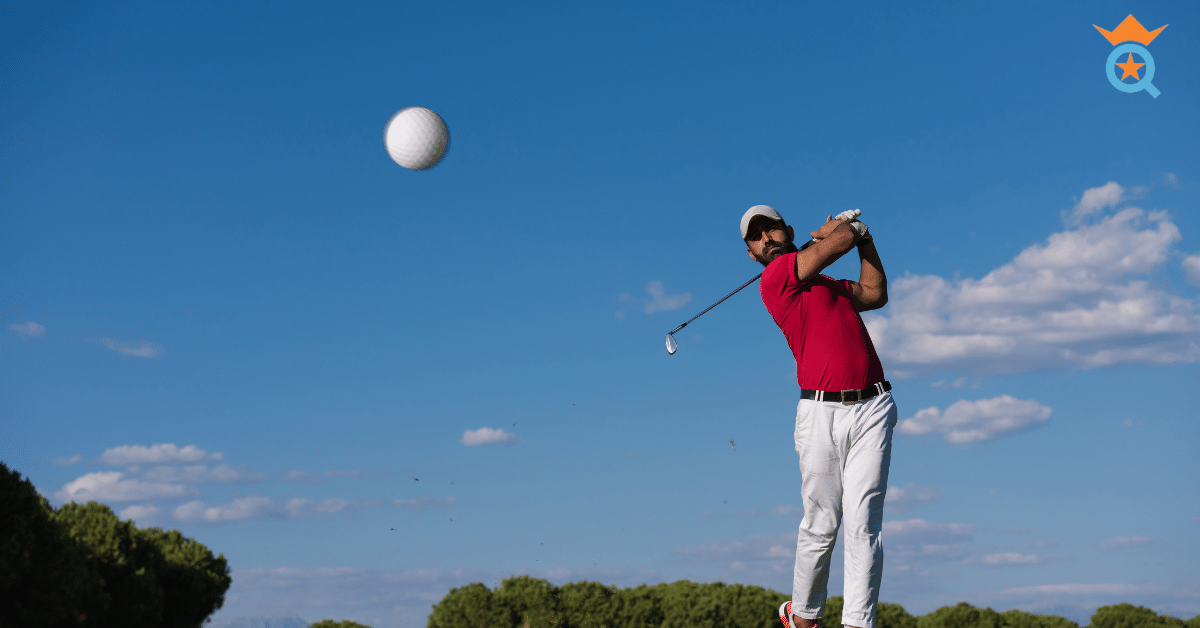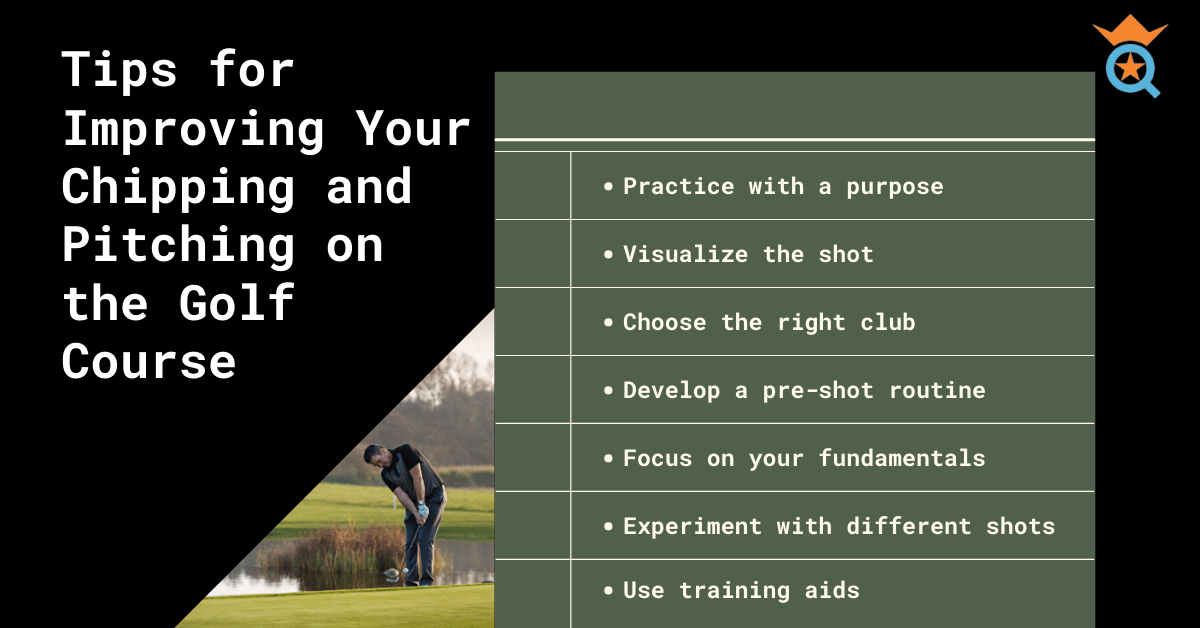In the game of golf, a strong short game can be the difference between an average player and a highly skilled one. Mastering chipping and pitching techniques is crucial for lowering scores and navigating through challenging situations on the golf course.
This article aims to provide valuable insights on the distinctions between chipping and pitching, proper ball positioning, and how to adapt your short game to various on-course scenarios.
With a professional and informative tone, we will guide you through the essential aspects of refining your short game and becoming a more proficient golfer.

Chipping vs Pitching: Understanding the Difference
When it comes to refining your short game in golf, it's essential to understand the distinctions between chipping and pitching. Both types of shots play a crucial role in navigating the course and setting up for successful putts, but they differ in trajectory, purpose, and the clubs used.
Chip Shot
A chip shot is a low-trajectory shot designed to spend minimal time in the air and roll along the ground toward the target, similar to a putt. Chip shots are typically used when you're close to the green and need to get the ball rolling in the direction of the hole. Golfers can execute chip shots using a variety of clubs, ranging from wedges to as low as a 7-iron.
Pitch Shot
On the other hand, a pitch shot involves a higher trajectory, carrying the ball further in the air and resulting in less roll once it lands. Pitch shots are ideal for situations where you need to cover a longer distance, up to around 30 yards, or when you need to clear obstacles such as bunkers or rough patches. For pitch shots, golfers generally use higher-lofted clubs like a 54, 56, 58, or 60-degree loft utility wedge.
In summary, while chip shots are low and focus on the roll, pitch shots are higher and involve more airtime. Choosing the right shot and club for each situation is vital for mastering your short game and achieving better scores on the golf course.

Ball Positioning for Chip Shots: Where Should the Ball Be Positioned When Chipping?
Achieving the desired trajectory and roll of a chip shot is highly dependent on proper ball positioning. Knowing where to position the ball in your stance when chipping will help you make clean contact and control the shot more effectively.
Ideal Ball Position for Chip Shots
For chip shots, the ideal ball position is slightly back or center in your stance. By placing the ball in this position, you promote a downward strike on the ball, allowing for the desired low trajectory and optimal roll toward the target.
How Ball Positioning Affects Trajectory and Roll
The position of the ball in your stance directly impacts the trajectory and roll of the chip shot. If the ball is positioned too far forward, the club will likely make contact with the ball on the upswing, resulting in a higher trajectory and less roll.
Conversely, if the ball is positioned too far back, the club may strike the ball with excessive downward force, causing the shot to be too low and possibly resulting in a "skulled" shot that travels too far.
Tips for Finding the Correct Ball Position When Chipping
- Begin by setting up with a narrow stance and feet no more than a foot apart.
- Place the ball slightly back of the center of your sternum, promoting a slight forward shaft lean and ensuring your hands are ahead of the ball.
- As a reference, the ball should be roughly under your trail eye.
- Experiment with small adjustments to find the ideal ball position that produces the desired trajectory and roll for your specific chipping style.
By understanding the importance of ball positioning for chip shots and using these tips to find the ideal placement, you'll be better equipped to execute accurate and controlled chip shots on the golf course.
Practice and adapt your technique to ensure consistent performance and improved results in your short game.
How Far to Stand from the Golf Ball When Chipping
When chipping, finding the appropriate distance to stand from the golf ball is essential for maintaining accuracy and control over your chip shots.
Generally, you should stand closer to the ball when chipping compared to a full swing. This closer position promotes a more upright posture and encourages a steeper angle of attack, which helps to ensure clean contact with the ball.
Standing too far away from the ball can lead to a more rounded swing path, increasing the likelihood of hitting the ball fat or thin, ultimately compromising the quality of the shot.
By standing at the correct distance from the golf ball when chipping, you can achieve better consistency and precision in your short game.

Pitch Shots: The Key to Mastering Difficult Lies
Flop shots are an essential component of any golfer's short-game arsenal. A flop shot is a high, soft shot that is executed with a high-lofted wedge, such as a lob or sand wedge, to achieve maximum height and minimum roll upon landing. This shot is particularly useful when facing difficult lies, such as when the ball is in deep rough or when you need to carry over an obstacle like a bunker.
Ball Positioning for Pitch Shots
For pitch shots, the ideal ball position is in the center of your stance. By positioning the ball in the center, you promote a more neutral angle of attack, allowing for a higher trajectory and a softer landing. This ball positioning helps to generate the necessary loft to execute an effective pitch shot.
Hitting Pitch Shots Effectively with Different Wedges
To hit pitch shots effectively using various wedges, consider the following tips:
- Choose the right club: Select a wedge with an appropriate loft for the shot at hand. For example, use a sand wedge (54-56 degrees loft) for moderate height and roll, and a lob wedge (58-60 degrees loft) for maximum height and minimal roll.
- Open the clubface: Slightly open the clubface at the address to utilize the bounce of the club, reducing the chances of digging into the turf or catching the ball fat.
- Maintain a consistent stance: Keep your feet shoulder-width apart, and place slightly more weight on your lead foot to promote a descending blow and clean contact.
- Employ a smooth, accelerating swing: Focus on a controlled backswing, and make sure to accelerate through impact, ensuring optimal trajectory and distance control.
- Use the bounce of the club: Allow the bounce of the club to glide through the turf, preventing the leading edge from digging in and resulting in cleaner contact and better results.
By understanding and implementing these tips, you can effectively execute pitch shots with different types of wedges, improving your short game and increasing your ability to navigate difficult lies on the golf course.
Adjusting Your Short Game for Ball Above and Below Your Feet
Hitting golf shots with the ball above or below your feet can be challenging, but with the right adjustments to your stance, swing, and club selection, you can successfully navigate these tricky situations.
Hitting a Golf Ball Above Your Feet
- Adjust your direction: When the ball is above your feet, it tends to hook or draw to the left for right-handed golfers (and to the right for left-handed golfers). Aim slightly right of your target to compensate for this natural curvature.
- Choke down on the club: Grip the club lower on the handle to maintain better control and balance during the swing.
- Widen your stance: This will help you maintain balance and stability throughout the swing.
- Choose a more lofted club: The ball will launch lower than usual due to the slope, so using a more lofted club can help counteract this effect.
Hitting a Golf Ball Below Your Feet
- Adjust your direction: When the ball is below your feet, it tends to fade or slice to the right for right-handed golfers (and to the left for left-handed golfers). Aim slightly left of your target to account for this curvature.
- Bend your knees: Increase the bend in your knees to lower your center of gravity and maintain solid contact with the ball.
- Play the ball forward in your stance: This will help you catch the ball cleanly and generate a higher trajectory.
- Swing on a more vertical plane: Steepening your swing will help ensure clean contact with the ball.
Tips for Hitting the Ball Above and Below Your Feet
- Maintain balance: Focus on keeping your weight centered and balanced throughout the swing, as uneven lies can cause you to lose stability.
- Swing with control: Avoid overswinging and prioritize making solid contact with the ball.
- Practice: Spend time on the practice range or the course, hitting shots from uneven lies to build confidence and hone your technique.
- Focus on tempo: Maintain a smooth, consistent tempo in your swing to ensure better contact and improved results.
By following these tips and making the necessary adjustments, you can effectively handle situations where the ball is above or below your feet, ultimately enhancing your short-game performance and overall golfing abilities.

Tips for Improving Your Chipping and Pitching on the Golf Course
Improving your chipping and pitching skills can make a significant difference in your overall golf performance. Here are some practical tips to help you refine your short game and lower your scores on the golf course:
- Practice with a purpose: Dedicate time during practice sessions to work specifically on chip shots and pitch shots. Focus on different lies, distances, and situations to simulate real course conditions.
- Visualize the shot: Before hitting a chip or pitch shot, visualize the trajectory, landing point, and roll-out of the ball. This mental exercise will help you commit to the shot and execute it with confidence.
- Choose the right club: Selecting the appropriate club for each situation is crucial. For chip shots, consider using anything from a 7-iron to a pitching wedge, depending on the required roll-out. For pitch shots, opt for higher lofted clubs like a sand wedge or lob wedge to achieve a higher trajectory and softer landing.
- Develop a pre-shot routine: Establish a consistent pre-shot routine that includes assessing the lie, choosing the club, visualizing the shot, and taking a few practice swings. This will help you stay focused and calm under pressure.
- Focus on your fundamentals: Pay attention to your stance, grip, and posture to ensure proper technique. Remember to keep your weight on your lead foot and maintain a narrow stance for better control during chip and pitch shots.
- Experiment with different shots: Practice various types of shots, such as bump-and-run, flop shots, and low-spinning pitches. This versatility will allow you to handle different situations on the course more effectively.
- Use training aids: Incorporate training aids like Swing Align into your practice sessions to improve your short-game mechanics and alignment. These tools can provide valuable feedback and help you develop a more consistent short game.
By following these tips and dedicating time to improving your chipping and pitching skills, you'll be better equipped to handle the challenges of the golf course and ultimately enjoy lower scores and more success on the greens.

Takeaways
Mastering your short game, including understanding the differences between chipping and pitching, is crucial for lowering your scores and becoming a more skilled golfer.
Throughout this article, we have explored various techniques and tips for improving hit chip shots and pitch shots, including proper ball positioning, adjusting to different lies on the golf course, and using the appropriate club for each situation.
Remember that a chip shot is a low trajectory shot designed to get the ball rolling towards the hole, while a pitch shot is a higher trajectory shot with a softer landing, meant for more challenging situations. Adapting to various ball positions, such as the ball is above or below your feet, requires adjustments in stance, golf swing, and club selection.
To continue improving your short-game skills, practice regularly, focusing on fundamentals and experimenting with different shots. Don't hesitate to use training aids like Swing Align to help refine your mechanics and alignment. By dedicating time and effort to your short game, you'll find greater success on the golf course and enjoy the benefits of a more well-rounded golf game.








